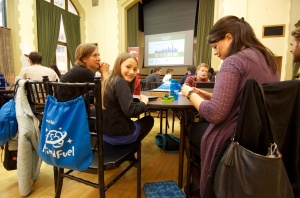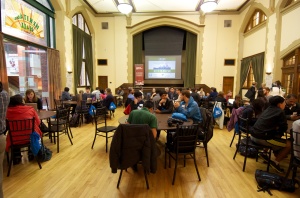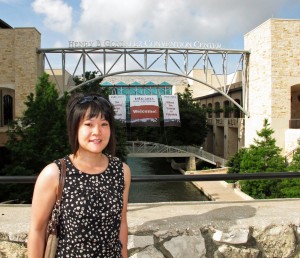Since last fall, I’ve had countless valuable experiences, beginning with my participation in Startup Weekend, which was the catalyst that started the journey that I am now on. This first taste led to collaborating with some of the most dedicated, caring, and hard working individuals I know, to host western Canada’s first ever education-themed Startup Weekend events in Calgary and Edmonton.

9-year old Lauren, team lead for the Crowd Favorite, How Do You Do? robotics kits, Calgary. Photo: Victor Panlilio.
Last week I had the opportunity to share what our Startup Weekend EDU team has learned at the University of Calgary Werklund School of Education Ideas 2015 conference. This week I am excited to be in gorgeous Niagara Falls, Ontario, sharing Startup Weekend EDU at the Connect 2015 conference.
Reflecting on all that we’ve learned has been an experience in itself. When I sat down to create my presentation, a flood of memories filled my head. I thought of every bit of insanity, hope, fun, and inspiration that make up Startup Weekend EDU. I thought about all of our participants: the retired educator, the nine-year-old student who loves robotics, the startup guru, the architect, the parent, the experienced judges, the pre-service teacher, and everyone who participated, mentored, or volunteered. I actually had a physical reaction while reflecting. I could feel heat creeping up my neck as the adrenaline began pumping and I re-experienced the feeling of doing something both scary and exciting.
I’ve packed my presentation (slides below) with a wealth of insights. Here are a few highlights that I’ll build upon during my presentation.
- Creating learning environments that foster creativity, risk taking, and innovation requires educators to experience these environments themselves. When was the last time you did something that was a real risk for you? Without doing it ourselves, can we truly understand how to shape these experiences for our students?

Our fantastic venue at the Southern Alberta Institute of Technology in Calgary, October 16-18, 2014. Photo: Victor Panlilio.
- Diversity in expertise, interests, and skills is the key to creating dynamic and authentic learning experiences. Students and educators must also apply their diverse expertise in authentic ways that impact the world. Collaborating with a network of people who know and think differently from one another is necessary across the education space if we are to create what is not yet known.
- Fostering entrepreneurial spirit in learning means thinking like and learning from entrepreneurs. It’s not just about telling educators and students to take risks and collaborate. It’s about fostering a culture in and out of the classroom through explicit opportunities to do so. In my presentation I’ll share a ton of strategies used by entrepreneurs all over the world, as well as tools that we’ve used at Startup Weekend EDU that you can easily apply in your own context.
You are invited to join me at Connect 2015 for Bringing Entrepreneurial Spirit to Life Through Startup Weekend EDU on Thursday, May 7th at 1:00 pm in room 206. See you soon!

